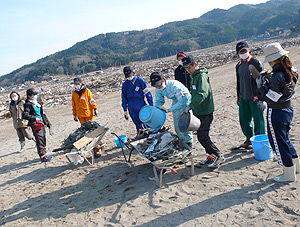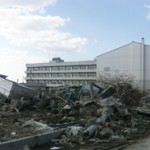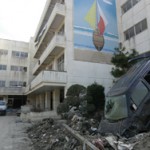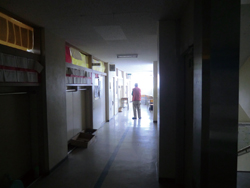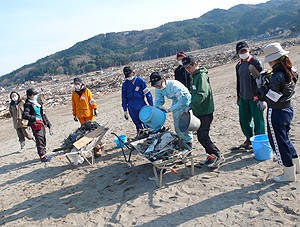A staff member of the Association for Aid and Relief (AAR) shared his experiences helping at an evacuation center in the Minato Middle School in the city of Ishinomaki (Miyagi Prefecture). He first arrived in mid-April, about one month after the earthquake struck, to deliver food, clothing, and many other items after a doctor working there had asked AAR for help. The school is not far from the Ishinomaki harbor, which was one of the hardest hit areas. The school’s windows were shattered and there was a car jutting into the air near the front gate. The stench from the rubble and sludge was so strong that he had to wear a mask, but the dust still seemed to stick in his throat. There was still no water or electricity, and people were using boxes as makeshift toilets. From the windows, all you could see was backhoes and other heavy equipment trying to remove the debris, and one evacuee sighed, “Being here, you hardly get a sense of what time or what season it is.”
There are now fewer evacuees at the school as some people have moved to other shelters or back to their homes, but since people lost their cars in the disaster, many who are trying to clean up and rebuild houses near the school have no choice but to stay. Two months after the disaster, there is still no plan to reopen Minato Middle School. There are no signs of electricity or water being restored in this area any time soon. And while the Self-Defense Forces (Japan’s military) are providing a minimal amount of supplies and meals, because this is a small center, there is uncertainty about how long those provisions will continue. While there have been promising signs of recovery in some parts of Tohoku, and many of the larger evacuation centers are getting a good stream of supplies, medical care, and other assistance, there are many others that are still suffering. AAR is committed to continuing to provide help to these victims.
NICCO posted an update on their progress to date and plans for the future. NICCO was one of the early NGOs on the scene as they began surveying the needs in the area just two days after the disaster struck. They have been providing medical care and counseling (mobile treatment, emotional care, and psycho-social care) in the cities of Natori and Iwanuma (Miyagi Prefecture) and Rikuzentakata (Iwate Prefecture). From May, their focus has been on providing care for the children of the region to prevent post-traumatic stress disorder (an anxiety disorder that results from being exposed to the threat of death or severe injury), using techniques that they have learned through their work in other countries. NICCO has also been helping to improve conditions at the evacuation centers in Rikuzentakata, providing 64 generators, 30 washing machines, 20 temporary toilets, and other supplies. They are continuing to coordinate volunteers to assist with meal preparation and cleanup of homes and schools in Kesennuma (Miyagi Prefecture) and Rikuzentakata.

